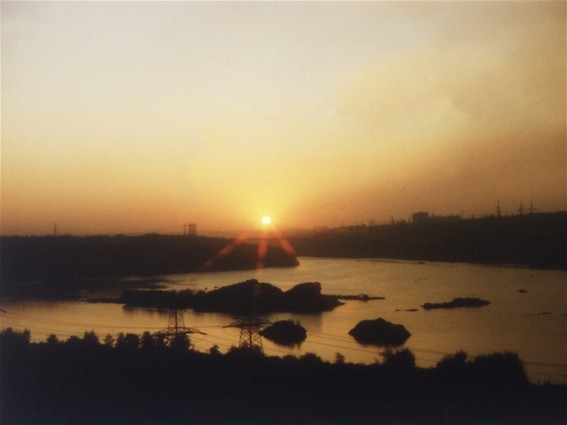Dnipro Rapids
Dnipro Rapids [Дніпровські пороги; Dniprovski porohy]. The Dnipro Rapids ceased to exist when they were inundated for 90 km between the cities of Dnipropetrovsk and Zaporizhia when the Dnipro Hydroelectric Station was built in 1932. This section of the Dnipro River, lying in the Ukrainian Crystalline Shield, was strewn with submerged and emerging cliffs, rocks, and boulders. Cliffs and rocks that cut a part of the current are called barriers (zabory), while those that cut across the whole river are known as rapids (porohy). The rapids, nine in number, lay within a 70 km stretch from Lotsmanska Kamianka, which is 15 km below Dnipropetrovsk, to the village of Kichkas (now inundated).
There were thirty barriers, six of which were located farther upriver between Kremenchuk and Dnipro. Over this 70 km stretch the riverbed dropped in elevation by 35.5 m, or 0.47 m/km. The decline was minimal between the rapids, while at the rapids it sometimes reached 1 percent fall and the current velocity reached 6 m/sec. The order of the rapids and larger barriers was the following: the Kodatskyi or Starokodatskyi Rapid with four falls, the Voloshynova Barrier, the small Surskyi Rapid, the Lokhanskyi Rapid with three falls, the Strilcha Barrier, the Zvonetskyi (or Dzvonetskyi) Rapid, the Tiahynska Barrier, the Nenasytets Rapid or Did Rapid (the largest) with seven falls, the Voronova and Kryva barriers, the Vovnizkyi (Vovnih, Vnuk) Rapid, and three smaller rapids—Budylo, Lyshnii, and Vilnyi or Hadiuchyi.
The rapids and barriers made continuous navigation on the Dnipro River impossible. They divided the navigable river into two sections: one above and the other below the rapids. Hence, in the 18th century when the whole Dnipro River came under Russian control, attempts were begun to regulate the Dnipro at the stretch of rapids. The first projects in 1785 by Col N. Faleev and in 1795–1807 by de Bolan did not achieve any important results. In 1843–54 canals were constructed on the left bank around all the rapids, and the most dangerous cliffs in the barriers were removed. But the canals were narrow and shallow; hence, instead of this new route many boats continued to take the old route (the ‘Cossack route’) through the natural gaps in the rapids and barriers along the right bank. Steamboats could not navigate this stretch of the Dnipro. Rowboats and sailboats navigated the rapids only when the water level was high. At low water only rafts got through the rapids, and they could travel only downstream with the current. Only the inundation of the rapids made navigation between the cities of Dnipro and Zaporizhia possible.
The Dnipro Rapids were mentioned by ancient Greek writers of the 1st century AD. The first accurate description of them was given in the mid-10th century by Constantine VII Porphyrogenitus in his De administrando Imperio. The rapids were a great hindrance to transportation along the Varangian route. They had to be circumvented by land. The steppe nomads, particularly the Pechenegs, ambushed the caravans of Kyivan Rus’ merchants at the rapids. Prince Sviatoslav I Ihorovych died in battle with the Pechenegs near Khortytsia Island in 972. On this island in the 16th century the Zaporozhian Sich (literally: ‘beyond the rapids’) was erected.
BIBLIOGRAPHY
Iavornyts'kyi, D. Dniprovi porohy (Kyiv 1928, repr Dnipropetrovsk, 1989)
Volodymyr Kubijovy�
[This article originally appeared in the Encyclopedia of Ukraine, vol. 1 (1984).]
[This article originally appeared in the Encyclopedia of Ukraine, vol. 1 (1984).]


